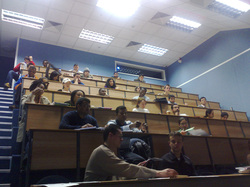| | But just to drive the point home, I’ll quote one. Tom Watkins was superintendent of Michigan’s schools from 2001 to 2005. He recently wrote in the Detroit News, “Between university debt, changing demographics, legacy costs, competition from for-profit educational institutions, soaring student debt, state funding cutbacks, philanthropy drying up, tenure and skyrocketing tuition and fees, we are heading for a crisis.” That isn’t too far from the tone of a report last year in The Economist, which looked at a consultant’s report that found long-term debt at not-for-profit universities growing at 12 percent a year. One-third of the 1,692 universities and colleges studied had weaker balance sheets than in years past. “Universities have been spending like students in a bar who think a Rockefeller will pick up the tab,” The Economist said. And as any parent of a child seeking higher education knows, a lot of that extra cost has been pushed onto students, who often end up with a diploma, dismal job prospects and a mountain of debt. It is against this backdrop that the Oregon Legislature has captured the spotlight by agreeing to study something known as “pay it forward.” Under this plan, Oregon residents could enroll at any state institution for free. Then, upon graduation, they would be obligated to pay a portion of their income (some have suggested 3 percent) for 24 years or so. It’s easy to dismiss Oregon as a place where strange ideas rise up and die. It’s a state where it remains illegal for motorists to pump their own gas. It is a place where statewide urban planning sets limits to sprawl, where people vote only by mail and where the idea of legal assisted-suicide first took hold. But, hey, if you entertain enough strange ideas, you might occasionally come across some good ones. Which is not to say that Oregon’s proposed “pay it forward” tuition plan is a good one. It is, however, the kind of innovative thinking that could lead to even better ideas. The plan’s appeal is that it doesn’t penalize students for choosing careers that don’t pay enormous sums. No longer would you graduate with an art history degree and $100,000 in debt. And supporters say the obligation would not, in a legal sense, qualify as debt at all. That means it wouldn’t count against a graduate’s credit rating when he or she tries to buy a house or obtain some other loan. But these may be the plan’s downfall, as well. Critics say students who major in subjects that promise high incomes would likely find other kinds of financing, leaving the program with a lot of low earners who won’t generate enough money to make the program pay for itself. And no one seems to know what would happen if a graduate moves out of state, or out of the country. A state can’t compel the IRS to tell it what someone in a different state earns, which would make it hard to exact a payment based on income. The state may find that this actually gives people a good reason to leave Oregon once they obtain their degree. Operating costs are a big concern. Some say the state would need about $9 billion upfront to start the program, with the thought that it would become self-sufficient in 25 years or so when a steady stream of money is pouring in from graduates. But these concerns are getting ahead of the issue. Oregon has decided only to study the idea and see whether it warrants a pilot program. It may be impossible to make such a thing profitable. By all means, states should look at ways to make it easier for young people to obtain a higher education. This plan’s biggest flaw, however, is that it does nothing to reduce university expenditures and the cost of obtaining a degree. Ultimately, the disruptive forces of the Internet may make that happen, with easy access to quality courses online. It doesn’t take an expert to see that coming, either. |
|
0 Comments
Your comment will be posted after it is approved.
Leave a Reply. |
Search this siteLike what you read here? Please subscribe below, and we'll let you know when there is a new opinion.
The author
Jay Evensen is the Opinion Editor of the Deseret News. He has more than 40 years experience as a reporter, editor and editorial writer in Oklahoma, New York City, Las Vegas and Salt Lake City. He also has been an adjunct journalism professor at Brigham Young and Weber State universities. Archives
July 2024
Categories
All
Links
|


 RSS Feed
RSS Feed

